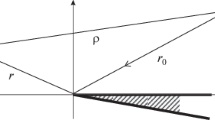Abstract
Thank to the Dirac’s fundamental quantum conditions between the position and momentum operators, we derive a formula showing that in a Fraunhofer diffraction of a plane wave with wave vector \( {\overrightarrow{\mathrm{k}}}_0 \) by a 3D object, the amplitude of the diffracted wave with wave vector \( \kern0.1em \overrightarrow{\mathrm{k}} \) is the product of the values of the Fourier transforms with respect to \( \overrightarrow{\Delta \mathrm{k}}\equiv \overrightarrow{\mathrm{k}}-{\overrightarrow{\mathrm{k}}}_0 \) of two functions, one of them represents the effect of the interaction causing by the object onto the wave and the other the form of the object. If the object is delimited by planes, we show that its representative function may be obtained from the Dirac and Heaviside functions of linear transforms \( \mathrm{U}\overrightarrow{\mathrm{r}} \) of \( \kern0.1em \overrightarrow{\operatorname{r}} \). The Fourier transform of the representative function may then be calculated thank to a simple formula involving the reciprocal vectors extracted from the matrices U and U− 1. As results, we find again, without utilizing the Huygens-Fresnel principle nor the Maxwell’s equations, the principal laws concerning Fraunhofer diffractions and interferences of plane waves in optics including the Fresnel Formulae. In obtaining the latters we find at the same time the factor representing the interaction effect between the waves and the medium, characterized by its index of refraction. As further examples of applications, the calculations for obtaining the amplitudes of diffractions by tetrahedra and oblique pyramids are given in details.





Similar content being viewed by others
References
M. Born and E.Wolf, Principles of Optics, Pergamon (1970)
E. Hecht, Optics, Addison-Wesley (2002)
G. Bruhat, Optique, Masson & Cie (1965)
P.A.M. Dirac, Quantum Mechanics, 4th ed., Oxford Univ. Press (1960)
K.B.Wolf, Integral transforms in Science and Engineering, Plenum Press (1979)
C. Cohen-Tannoudji, B. Diu, F. Laloë, Quantum mechanics (Wileyand Hermann, Paris, 1977)
J.J.Sakurai, Modern Quantum Mechanics, Addison-Wesley Inc., pp 379-386 (1994)
Acknowledgments
The author respectfully dedicates this work to Prof. Nguyen Chung Tu who had taught him optics and abc in quantum mechanics at the Saigon Faculty of Sciences, now HochiMinhcity Natural Sciences University and to Prof. Dagonnier R who had given him the love for researches when he was his assistant at the State University of Mons, Belgium. Many thanks also to my family and Prof. Le Minh Triet, vice- president of the HochiMinh-city Association of Physicists for their encouragement during this work.
Author information
Authors and Affiliations
Corresponding author
Rights and permissions
About this article
Cite this article
Si, D.T. On amplitudes of Fraunhofer diffractions of waves by 3D objects. Applications to half-spaces and oblique pyramids. J Opt 43, 219–230 (2014). https://doi.org/10.1007/s12596-014-0202-0
Received:
Accepted:
Published:
Issue Date:
DOI: https://doi.org/10.1007/s12596-014-0202-0



